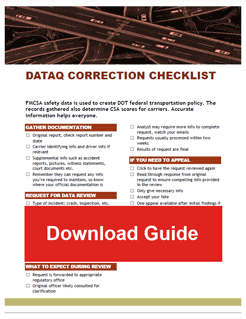The Ultimate Guide to Disputing Negative DataQs
How to Successfully Complete a DataQ Appeal
The Federal Motor Carrier Safety Administration’s (FMCSA) DataQ system may seem intimidating, especially when it comes to correcting your safety records. However, with the right information and guidance, navigating this system is easier than it may seem. The key is to understand how the DataQ system works and, more importantly, how it can work in your favor.
Understand how to navigate the DataQ System
The DataQ system is an integral part of the FMCSA’s Compliance, Safety, and Accountability (CSA) program. It allows users to request and track a review of Federal and State data issues. A clear understanding of how the system operates is essential in ensuring that your safety records are accurate and up-to-date.
- Monitoring and Changing Safety Data: Christopher Turner, the Director of Enforcement Data and Judicial Outreach for CVSA, provides an insightful walkthrough on how to monitor and change safety data. In this walkthrough, he demonstrates how carriers can protect themselves from incorrect information.
- Importance of Safety Records: Your safety record is a crucial aspect of your company’s reputation. Parts of this record can be accessed by potential clients, insurance companies, competitors, potential employees, and the public. As such, it’s critical for your success to ensure the accuracy of your records.
Navigating the DataQ System
Understanding how the DataQ system works is the first step towards ensuring that your safety records are accurate. Here are some steps to effectively navigate the DataQ system:
- Creating a DataQ Account: The first step is to create a DataQ account. This allows you to submit challenges to the data contained in your safety record. Already have an DataQs account? Click the following link and use your DataQs Login.
- Submitting a DataQ Challenge: After creating an account, you can submit a DataQ challenge. This involves identifying the specific data you wish to challenge, providing an explanation as to why you believe the data is incorrect, and submitting any supporting documentation.
- Reviewing a DataQ Challenge: Once you’ve submitted a challenge, it will be reviewed by the relevant authorities. You can track the status of your challenge through your DataQ account.
- Resolving a DataQ Challenge: After a review, the authorities will make a decision regarding your challenge. If they agree with your challenge, the data in question will be corrected.
Understanding the DataQ system and how to navigate it is crucial in maintaining the accuracy of your safety records. With the right knowledge and guidance, you can effectively use the system to protect your company from incorrect information. Ensuring the accuracy of your safety records not only protects your reputation but also contributes to the overall safety of the transportation industry. We have published free DataQ webinars below to better explain the process.
View all The Webinars by clicking the hamburger playlist icon below ↓
Webinar Replay #27 delves into dismantling DataQs for easier use cases.
This DataQ webinar focused on ‘Dismantling DataQs’. Craig Hart and Mark Rhea hosted the event, with Chris Turner, the director of crash and data programs with the Commercial Vehicle Safety Alliance. The webinar aimed to provide comprehensive insights into DataQ operations, covering both best practices and pitfalls.
Key points discussed:
- Basics of DataQ operation and strategies for achieving good results
- Common mistakes to avoid in DataQ processes
- Addressing pre-event questions and live queries from attendees
In conclusion, the webinar leveraged the hosts’ and guest’s extensive industry experience to offer valuable information and clarify doubts about DataQs, making it a beneficial resource for attendees in the trucking industry.
Webinar Replay #44 goes into where to start with the DataQ system and its uses.
This DataQ webinar is hosted by Mark Rhea and featuring Brandon Wiseman, focused on Safety Management Systems (SMS) and Compliance, Safety, Accountability (CSA) programs. Wiseman highlighted the importance of the Safety Measurement System for regulated carriers and its impact on various aspects of their operations. The discussion also covered upcoming changes to the CSA platform, which are a result of criticisms and instructions from the U.S. Congress to improve the system.
Key points:
- SMS collects data from roadside inspections and audits, categorized into seven basics
- The system influences commercial auto liability insurance premiums and relationships with shippers and brokers
- Significant changes to the SMS system are expected in the near future
The webinar provided valuable insights into the current SMS system and its implications for carriers, emphasizing the importance of monitoring and improving CSA scores in light of upcoming changes.
Webinar Replay #53 talks about the effective use of the DataQ system.
This DataQ webinar, led by Steve Kessler, discusses the DataQ system, a tool for transportation companies to challenge information held by the FMCSA. Richard Goins, an industry veteran, with over 30 years of experience as a driver, fleet manager, and trainer, shares insights on effectively using the DataQ system to dispute violations within policy. The discussion emphasizes the importance of understanding the system, focusing on correcting errors, and communicating effectively with reviewers.
Key takeaways:
- Infinit-I Workforce Solutions offers a comprehensive learning management system for transportation companies
- The DataQ system allows companies to dispute violations, but should be used judiciously
- When presenting facts for review, it’s crucial to remember the audience and their expertise
The webinar provides valuable insights for transportation companies on navigating FMCSA regulations and maintaining a strong safety record through effective use of the DataQ system.
Understanding the DataQ System
The Federal Motor Carrier Safety Administration (FMCSA) has developed a system known as the DataQ system which is instrumental in the gathering and maintenance of safety data. This system is used by carriers, drivers, as well as federal and state agencies to record and dispute any discrepancies on the provided safety data. The DataQ system is more than just a tool for recording data, it is a platform that fosters transparency and accuracy in the trucking industry.
The Department of Transportation (DOT) primarily uses the data collected through this system to evaluate the effectiveness of current programs and to help shape new federal transportation policies. The data is instrumental in painting a clear picture of the current state of the industry. Although the system was initially designed to support safety enforcement programs, it has evolved to become a valuable resource for trucking companies and their drivers.
- Understanding the Importance of the DataQ SystemThe DataQ system is not just a tool for data collection, it is a platform that allows for the review and correction of data. This is important because the data collected can significantly affect Compliance, Safety, Accountability (CSA) scores. CSA audit information scores are used by the FMCSA to identify high-risk motor carriers. As such, it is crucial for companies to ensure that the data recorded is accurate. For instance, an incident incorrectly assigned to a company or a duplicate record can negatively impact CSA scores. Through the DataQ system, companies can file for a request for data review to correct such inaccuracies.
- How the DataQ System WorksThe DataQ system is structured in a way that promotes transparency and accountability. When a request for data review is filed, the concerned agency or carrier is notified. The agency or carrier then has the opportunity to respond to the request, after which the FMCSA makes the final decision.
- The Role of the DataQ System in the Trucking Industry
- Promoting Safety: The DataQ system allows for the tracking and recording of safety data. This data is then used to identify areas of concern and implement necessary safety measures.
- Influencing Policy: The data collected is used by the DOT to evaluate current programs and develop new federal transportation policies.
- Enhancing Transparency: The DataQ system promotes transparency by allowing carriers, drivers, and agencies to view and dispute safety data.
The FMCSA’s DataQ system is a vital tool in the trucking industry. It promotes safety, influences policy, and enhances transparency. Most importantly, it provides an avenue for trucking companies and drivers to ensure their records are accurate, ultimately contributing to a safer and more accountable trucking industry.
Supporting Your Request for Data Review
When you’re requesting a review of data through DataQ, it’s crucial to take several steps to ensure your request is as accurate and comprehensive as possible. Below, we’ll delve deeper into the process and what you should be mindful of to avoid any delays or issues.
1. Accuracy of Basic Report Information: The accuracy of the basic report information you provide, such as report numbers and the state, is vital. Incorrect or inconsistent information can cause delays in your request. Always double-check if you have the correct dates and times.
2. Clarity in Event Description: The description of the event for review needs to be clear, concise, and factual. Avoid ambiguity or unnecessary details as it can cause confusion and result in an unsuccessful request. Stick strictly to the facts and avoid presenting any biased or subjective information.
3. Supplemental Information: The DataQ system allows you to attach supplemental information to support your request. This can include relevant pictures, accident reports, or witness statements. If you have any records that can provide compelling evidence, it’s recommended to make use of them. However, ensure that these documents are relevant and can add value to your request.
4. Preparedness for Further Information Requests: It’s possible that the person reviewing your request may require further information to help them make a decision. Therefore, make sure to have all relevant documentation readily available to send. Remember, you only get one opportunity to appeal a decision, so you need to make everything count.
5. Use of the DataQ System: The DataQ system is designed to be user-friendly and efficient. However, if you encounter any issues or have any queries, don’t hesitate to reach out to the DataQ helpdesk.
6. Importance of the Request: It’s important to remember that your request has real-world implications. If your request is successful, it can lead to changes in your CSA scores, insurance rates, or the outcome of legal proceedings. Therefore, it’s essential to pay careful attention to your request and ensure it’s as accurate and comprehensive as possible.
7. Appeal Process: If your request is unsuccessful, you have the right to appeal the decision. However, you only get one chance to do this, so it’s crucial to gather all the necessary information and prepare your case thoroughly before proceeding with an appeal.
When submitting a request for data review through DataQ, pay careful attention to the accuracy of your report information, the clarity of your event description, the supplemental information you provide, and be prepared for further information requests. Using the DataQ system to its full potential can help you achieve the desired outcome and avoid any unnecessary delays or issues.
Preparing for Disputes
Preparing for disputed DataQs is of paramount importance for any transportation company. With over 69,000 crashes involving large trucks and buses in 2021 thus far, it’s no surprise that reports can sometimes get mixed up. Ensuring the accuracy and reliability of safety reports is therefore critically essential.
The process of preparing for disputed DataQs begins at the very scene of the incident. Drivers need to be sufficiently equipped with the knowledge of what to do and what to say when an accident happens. They must gather as much data as possible, as this would significantly aid in the successful completion of a request for data review.
Here is a brief guide for drivers on handling the aftermath of an accident:
- Stay Calm: Keep a level-headed and clear mind. Panic can lead to unnecessary mistakes.
- Record the Scene: Use a camera or smartphone to take pictures of the accident scene from different angles. This could serve as irrefutable evidence.
- Collect Information: Write down the names, contact details, and insurance information of all parties involved. Also, note down the names and badge numbers of any responding police officers.
- Get Witnesses: If possible, get the contact details of any witnesses who saw the incident.
Understanding the type of information you want to change is also crucial. Is it a crash report, an inspection report, registration details, or something else? The reason for the changes is equally important, whether it’s due to an incorrect violation or a report assigned to the wrong carrier.
In preparing your DataQ dispute, ensure to have all relevant information handy. This includes:
- Report Details: Have the specifics of the report, such as the report number and codes readily available.
- Supporting Evidence: Any supporting evidence such as photos or witness statements should be included.
- Justification: A clear and concise explanation of why you believe the data is incorrect.
Remember, the original officer may be consulted during the review process, so it is imperative that all the information provided in the DataQ dispute is accurate and verifiable.
Preparing for a disputed DataQ involves being proactive at the accident scene, understanding the type of information you want to change and why, and having all relevant information available for the review process. This not only helps in ensuring the accuracy of your safety reports but also contributes to the overall safety and reputation of your transportation company.
Improving Your Safety Data
Requests for data review are useful to help improve your safety data. You can dispute inspection related data up to 3 years from the inspection date, and crash data up to 5 years. With a good understanding of how to navigate the DataQ system works, your chances of correcting the record are high.
You can also improve your safety data with proper training. A good orientation process, recurring training, and follow-up after incidents shows your company’s dedication to keeping the roads safe. This training should include what to do at the scene of an accident or inspection.
Combining training with policies your drivers can understand and follow reduces your chances of nuclear verdicts in case of a claim. This will help towards improving your safety data. The less claims you have against your company, the better your chances of correcting records.
Keeping drivers up to date on changes in regulations will help them maintain needed documentation and procedures. Provide checklists where necessary to ensure proper maintenance and inspection procedures. Taking the time to check on the safety of the vehicle before hitting the road will reduce incidents.
Safety is a top priority for any business, particularly those in industries such as transportation and logistics where safety data plays a crucial role. The DataQ system is a valuable tool that allows businesses to review and dispute safety data, ensuring the most accurate records possible. This article provides insights into how you can leverage the DataQ system to improve your safety data.
Understanding the DataQ System
The DataQ system is an online tool that allows you to request a review of Federal and State data issued by the Federal Motor Carrier Safety Administration (FMCSA). This system allows you to dispute inspection-related data up to three years from the inspection date, and crash data up to five years. Having a good understanding of how to navigate the DataQ system is pivotal to your success in correcting any inaccuracies in your records.
- Create a Request: You can create a request for data review through the DataQ system. This process allows you to dispute any inaccuracies in your safety data.
- Monitor Your Request: Once your request has been submitted, you can monitor its progress through the system. This allows you to stay up-to-date on the status of your request and any changes made to your data.
Improving Safety Data with Training
Proper training can significantly improve your safety data. By implementing a robust orientation process, recurring training, and follow-ups after incidents, you’re demonstrating your company’s commitment to safety. This not only helps improve your safety records but also enhances your company’s reputation.
- Orientation Process: An effective orientation process educates new hires about your company’s safety standards, policies, and procedures.
- Recurring Training: Regular training sessions help keep your employees up-to-date on the latest safety guidelines and regulations.
- Follow-up After Incidents: Conducting a follow-up after an incident allows you to learn from the situation, make necessary adjustments to your safety protocols, and prevent similar incidents in the future.
Combining Training with Policies
Combining effective training with clear and understandable policies reduces the risk of incidents and claims against your company. This combination is a proactive approach to improving your safety data.
- Clear Policies: Clear and comprehensive policies that your employees can understand and follow are crucial. These policies should include safety guidelines, procedures for reporting incidents, and steps to take in case of an accident.
- Recurring Training: Regular training sessions ensure that your employees are knowledgeable about your policies and can apply them effectively.
Keeping Drivers Updated
Keeping drivers updated on changes in regulations is another key factor in improving your safety data. Providing checklists for proper maintenance and inspection procedures ensures that vehicles are safe before hitting the road, thus reducing incidents.
Improving safety data is not a one-time effort, but an ongoing process. By understanding how to navigate the DataQ system, implementing effective training and policies, and keeping drivers updated, you can significantly improve your safety data and contribute to safer roads. Remember, the less claims against your company, the better your chances of correcting records and maintaining a strong safety profile.
Protect Your Reputation
In today’s world, a company’s reputation is its most valuable asset. This is particularly true for organizations in the transport industry, where safety is paramount. High Compliance, Safety, and Accountability (CSA) scores can deter potential clients and alarm insurance companies. Therefore, it’s essential to invest in robust tools that can help monitor and improve safety data, which in turn safeguards your company’s reputation.
The first line of defense in protecting your reputation is proper training. Quality training equips your drivers with the necessary knowledge and skills to meet regulations and reduce incidents on the road. It’s crucial to choose training solutions that offer simple assigning, tracking, and reporting tools to ensure your drivers are adequately prepared.
Infinit-I Workforce Solutions provides these essential tools, ensuring easy access for your drivers. This convenience facilitates regular and effective training which is crucial in maintaining high safety standards. Using the Infinit-I Workforce Solutions can lead to a reduction in accidents, saving money, and increasing productivity.
To understand these benefits in detail, consider the following points:
- Reduction in Accidents: Regular training ensures that drivers are up to date with the latest safety regulations and best practices. This knowledge reduces the chance of accidents, ensuring the safety of not only your drivers but also other road users.
- Cost Savings: Fewer accidents mean less money spent on vehicle repairs and insurance premiums. Moreover, avoiding costly lawsuits resulting from accidents can save your company significant amounts of money.
- Increased Productivity: Well-trained drivers are more confident and efficient, leading to improved productivity. They are less likely to make mistakes that can lead to delays or downtime.
- Improved CSA Scores: Regular training and fewer accidents will lead to improved CSA scores. High scores can attract more clients and make your company more appealing to insurance companies.
One key tool in the Infinit-I Workforce Solutions suite is DataQ. DataQ is an innovative system that lets you:
- Monitor CSA scores: DataQ allows you to keep a close eye on your CSA scores, alerting you to any potential issues before they become significant problems.
- Address Discrepancies: If there are discrepancies in your CSA scores, DataQ allows you to challenge them, ensuring your scores are accurate and fair.
- Improve Training: By highlighting areas where your drivers may need additional training, DataQ helps you tailor your training programs to meet your drivers’ needs.
Requesting a free demo of Infinit-I Workforce Solutions is the first step towards protecting your company’s reputation, improving safety, and increasing productivity. Explore how DataQ and other tools in the Infinit-I Workforce Solutions suite can work for you.
FAQs
What is the benefit of a training management system?
A training management system equips drivers with necessary knowledge and skills to meet regulations and reduce incidents on the road. It also offers simple assigning, tracking, and reporting tools which are crucial in maintaining high safety standards.
How can a training management system aid in reducing CSA scores?
Regular training ensures that drivers are up-to-date with the latest safety regulations and best practices, leading to fewer accidents and improved CSA scores.
Can a training management system save my records for DataQ appeals?
Yes, a training management system can effectively document all your training records, which you can then use as evidence in a DataQ appeal if necessary.
How does a training management system promote safer trucking?
By providing regular and effective training, a training management system can equip drivers with the knowledge and skills necessary to avoid accidents, promoting safer roads.
Can a training management system improve ROI?
Yes, fewer accidents mean less money spent on vehicle repairs and insurance premiums. Moreover, well-trained drivers are more efficient, which can lead to improved productivity and a better return on investment.
How can a training management system help in reducing costs?
Fewer accidents result in lower costs for vehicle repairs and insurance premiums. Additionally, avoiding costly lawsuits resulting from accidents can save your company significant amounts of money.
How does a training management system impact a company’s reputation?
Regular training and fewer accidents can lead to improved CSA scores, which can enhance your company’s reputation in the industry.
Can a training management system help in tailoring training programs to driver’s needs?
Yes, by highlighting areas where drivers may need additional training, a training management system can help you customize your training programs to meet your drivers’ needs.
Can a training management system alert me to potential issues with CSA scores?
Yes, certain systems like DataQ can monitor your CSA scores and alert you to any potential issues before they become significant problems.
How does a training management system ensure accuracy of CSA scores?
If there are discrepancies in your CSA scores, systems like DataQ allow you to challenge them, ensuring your scores are accurate and fair.
Is the data from a training management system helpful in DataQ disputes?
Yes, the data and records from a training management system can be invaluable when challenging discrepancies in your CSA scores through DataQ.
Can a training management system help in preparing for DataQ disputes?
Yes, having all relevant training information and records available from your training management system can help in preparing your DataQ dispute.
How can a training management system help in maintaining high safety standards?
Regular and effective training facilitated by a training management system is crucial in maintaining high safety standards.
What kind of information is important to have on hand from a training management system when preparing for a DataQ dispute?
Report details, supporting evidence, and a clear and concise explanation of why you believe the data is incorrect are all important to have on hand from your training management system.
Can a training management system help in reducing the risk of incidents and claims against my company?
Yes, effective training combined with clear and understandable policies reduces the risk of incidents and claims against your company.
What are the real-world implications of a training management system?
A successful request for data review can lead to changes in your CSA scores, insurance rates, or the outcome of legal proceedings. Therefore, a training management system plays a crucial role in these areas.















